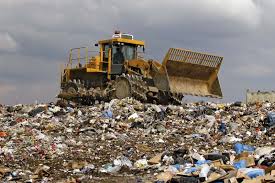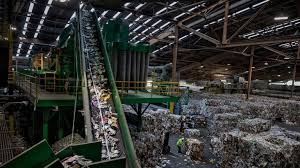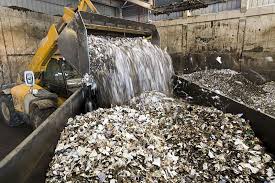The Practical Steps to Convert Steel Cans Wastes into New Steel Products; Steel cans wastes can be turned into new steel products, this is good because it helps to save energy and resources. When we recycle steel cans, we don’t need to make new steel from scratch, this means we use less energy and fewer raw materials, which is good for the environment.
First, we collect steel cans from homes, businesses, and other places. Then, we take them to a recycling facility. At the recycling facility, the steel cans are sorted and cleaned. This is important because we don’t want any other materials, like paper or plastic, mixed in with the steel.
Once the steel cans are clean, they are melted down in a furnace. This turns them into molten steel. The molten steel is then poured into molds to make new steel products. These products can be anything made of steel, like car parts, appliances, or even new steel cans!
By converting steel cans wastes into new steel products, we reduce the amount of waste that ends up in landfills. This helps to protect the environment and keep our communities clean. Additionally, recycling steel saves energy because it takes less energy to melt down and recycle steel than it does to make new steel from iron ore.
Converting steel cans wastes into new steel products is a great way to help the environment and conserve resources. By recycling steel, we can reduce waste, save energy, and create new products without harming the planet. It’s a simple way that everyone can contribute to a cleaner, greener future.
Read Also: Meaning of Ultrafiltration and Basic Principles and Processes of Ultrafiltration
Types of Recyclable Steel Cans Wastes and their Uses

Steel cans come in various types, each serving a different purpose and often found in different products. Here are some common types of recyclable steel cans wastes and their potential uses:
1. Food Cans: These are the most common type of steel cans wastes found in households. Food cans are used for packaging items like vegetables, fruits, soups, and meats. Once recycled, the steel from food cans can be used to make new food cans or other steel products like automotive parts or construction materials.
2. Beverage Cans: Beverage cans are used to contain drinks such as soda, beer, and energy drinks. After recycling, the steel from beverage cans can be used to manufacture new beverage cans or other steel products like bicycles, furniture, or kitchen appliances.
3. Aerosol Cans: Aerosol cans are often used for products like spray paints, air fresheners, and cooking sprays. These cans are recyclable, and the steel recovered from them can be used in various applications, including manufacturing automotive parts, metal furniture, or even structural beams for buildings.
4. Chemical and Paint Cans: Steel cans are also used to package chemicals, paints, and coatings. Recycling these cans allows the steel to be repurposed for making new containers, as well as products like tools, machinery, or industrial equipment.
5. Pet Food Cans: Cans used for packaging pet food are typically made of steel. After recycling, the steel from pet food cans can be used to create new packaging for pet products or repurposed into items like garden tools, fencing materials, or household appliances.
6. Soup and Soup Stock Cans: These cans are commonly used for packaging canned soups, broths, and other liquid food items. The steel recovered from these cans can be melted down and reused in the production of new cans, as well as other steel products like pipes, wire, or automotive components.
By recycling these various types of steel cans wastes, we can conserve resources, reduce energy consumption, and minimize the environmental impact associated with the production of new steel. It’s important for individuals and businesses to participate in steel can recycling programs to ensure that these valuable materials are properly reused and repurposed.
How to Convert Steel Cans Wastes into New Steel Products

Converting steel cans wastes into new steel products involves several steps in a recycling process. Here’s a simplified overview of how it’s done:
1. Collection: Steel cans are collected from homes, businesses, recycling centers, and other locations. Collection can be done through curbside recycling programs, drop-off centers, or specialized collection services.
2. Sorting: Once collected, the steel cans are sorted from other recyclables like paper, plastic, and glass. This is typically done either manually by workers or using automated sorting machines.
3. Cleaning: After sorting, the steel cans are cleaned to remove any remaining food residue, labels, or other contaminants. This ensures that the recycled steel is of high quality and suitable for use in new products.
4. Shredding and Melting: The cleaned steel cans are then shredded into small pieces or flattened into sheets. These shredded or flattened pieces are then melted down in a furnace at high temperatures. This process turns the steel into molten metal, which can be easily shaped and molded into new products.
5. Casting or Rolling: Once melted, the molten steel is either cast into molds to create specific shapes or rolled into sheets of various thicknesses. The choice between casting and rolling depends on the desired final product.
6. Cooling and Forming: After casting or rolling, the newly formed steel products are allowed to cool and solidify. They may undergo additional forming processes, such as cutting, bending, or stamping, to achieve the desired shape and dimensions.
7. Finishing: Finally, the newly formed steel products may undergo finishing processes such as painting, coating, or galvanizing to enhance their appearance, durability, or corrosion resistance.
8. Distribution: Once the new steel products are finished, they are ready to be distributed and used in various applications. These may include construction, automotive manufacturing, consumer goods, and more.
By following these steps, steel cans wastes can be effectively recycled and transformed into new steel products, helping to conserve resources, reduce waste, and minimize environmental impact. It’s important for individuals, businesses, and communities to support recycling efforts and participate in steel can recycling programs to ensure the sustainability of this process.
The Benefits of Converting Steel Cans Wastes into New Steel Products
Converting steel cans wastes into new steel products offers numerous benefits for the environment, economy, and society as a whole. Here are some of the key advantages:
1. Resource Conservation: Recycling steel cans helps conserve natural resources by reducing the need for raw materials such as iron ore, coal, and limestone. By using recycled steel, we can preserve valuable resources for future generations and reduce the environmental impact of resource extraction.
2. Energy Savings: Recycling steel cans requires much less energy than producing new steel from raw materials. The energy savings can be significant, as recycling steel reduces the need for energy-intensive processes like mining, transportation, and refining. This helps lower greenhouse gas emissions and mitigates climate change.
3. Waste Reduction: Converting steel cans wastes into new steel products diverts waste from landfills, where it would otherwise take up space and contribute to pollution. Recycling steel cans helps reduce the amount of waste that ends up in landfills, prolonging their lifespan and reducing the need for new landfill sites.
4. Economic Benefits: Recycling steel cans creates economic opportunities by supporting jobs in collection, sorting, processing, and manufacturing. Recycling industries also generate revenue through the sale of recycled materials, contributing to local economies and stimulating economic growth.
5. Environmental Protection: By reducing the demand for new steel production, recycling steel cans helps mitigate environmental impacts associated with steel manufacturing, such as air and water pollution, habitat destruction, and ecosystem disruption. This contributes to overall environmental protection and helps preserve natural ecosystems.
6. Promotion of Sustainable Practices: Converting steel cans wastes into new steel products promotes sustainable practices and encourages individuals, businesses, and communities to adopt environmentally friendly behaviors. Recycling steel cans raises awareness about the importance of resource conservation and waste reduction, inspiring people to make positive changes in their daily lives.
7. Circular Economy: Recycling steel cans contributes to the development of a circular economy, where materials are reused, recycled, and repurposed to create new products. By closing the loop on the steel production cycle, we can minimize waste, maximize resource efficiency, and create a more sustainable future.
Overall, the benefits of converting steel cans wastes into new steel products are far-reaching and multifaceted. By embracing recycling and supporting efforts to reduce, reuse, and recycle steel cans, we can build a more resilient, prosperous, and sustainable society for generations to come.
Read Also: Physic-Chemical Treatment Process
The Uses and Benefits of Recycled New Steel Products

Recycled new steel products offer a wide range of uses and benefits across various industries and applications. Here are some examples:
1. Construction: Recycled new steel products are commonly used in the construction industry for building structures such as bridges, skyscrapers, residential buildings, and commercial complexes. Steel beams, columns, and reinforcement bars made from recycled steel provide strength, durability, and resistance to corrosion, making them ideal for construction projects of all sizes.
2. Automotive Manufacturing: Recycled new steel products are essential in the automotive industry for manufacturing vehicles, including cars, trucks, buses, and motorcycles. Recycled steel is used to produce body panels, chassis components, engine parts, and other automotive parts, offering lightweight yet strong solutions that improve fuel efficiency, safety, and performance.
3. Appliances: Recycled new steel products are widely used in the manufacturing of household appliances such as refrigerators, washing machines, dishwashers, and ovens. Steel casings, shelves, racks, and internal components made from recycled steel are durable, corrosion-resistant, and environmentally friendly, making them a preferred choice for appliance manufacturers and consumers alike.
4. Packaging: Recycled new steel products are utilized in the packaging industry for manufacturing containers, cans, drums, and packaging materials. Steel packaging made from recycled steel offers excellent protection, preservation, and recyclability, making it ideal for storing and transporting food, beverages, chemicals, and other goods in a safe and sustainable manner.
5. Infrastructure: Recycled new steel products play a vital role in infrastructure projects such as railways, pipelines, ports, and airports. Steel rails, pipes, beams, and structural elements made from recycled steel provide the strength, durability, and reliability needed to support critical infrastructure systems and facilitate efficient transportation and communication networks.
6. Furniture and Home Goods: Recycled new steel products are commonly used in the manufacturing of furniture, home goods, and consumer products. Steel frames, shelves, tables, chairs, and decorative items made from recycled steel offer style, functionality, and sustainability, enhancing the comfort, convenience, and aesthetics of homes and workplaces.
7. Environmental Benefits: The use of recycled new steel products offers numerous environmental benefits, including resource conservation, energy savings, waste reduction, and greenhouse gas emissions mitigation. By utilizing recycled steel instead of virgin steel, we can reduce the demand for natural resources, minimize environmental impact, and contribute to a more sustainable future for the planet.
Overall, recycled new steel products offer versatile, durable, and sustainable solutions for a wide range of industries and applications. By embracing the use of recycled steel and supporting efforts to recycle steel products, we can promote environmental stewardship, economic prosperity, and social responsibility in our communities and beyond.
The Challenges of Converting Steel Cans Wastes into New Steel Products and their Solutions
Converting steel cans wastes into new steel products comes with several challenges, but there are also solutions to address these obstacles. Here are some common challenges and their potential solutions:
1. Contamination: Steel cans collected for recycling may contain contaminants such as food residue, paper labels, or plastic coatings. Contamination can affect the quality of the recycled steel and may require additional processing steps.
Solution: Implementing effective sorting and cleaning processes can help minimize contamination. Educating consumers about proper recycling practices and providing clear guidelines for separating steel cans from other materials can also reduce contamination levels.
2. Collection Infrastructure: Establishing and maintaining a reliable collection infrastructure for steel cans recycling can be challenging, particularly in areas with limited access to recycling facilities or collection services.
Solution: Investing in infrastructure improvements, such as expanding curbside recycling programs, installing more recycling bins in public spaces, and partnering with businesses to facilitate collection, can help increase the availability and convenience of steel cans recycling options.
3. Transportation and Logistics: Transporting steel cans from collection points to recycling facilities can be costly and logistically challenging, especially in rural or remote areas.
Solution: Optimizing transportation routes, coordinating collection efforts with other recycling programs, and leveraging technology to track and manage logistics can help streamline the transportation process and reduce associated costs.
4. Energy Consumption: While recycling steel cans saves energy compared to producing new steel from raw materials, the recycling process still requires energy for collection, sorting, processing, and transportation.
Solution: Investing in energy-efficient technologies, using renewable energy sources, and optimizing processes to minimize energy consumption can help reduce the environmental impact of steel cans recycling and improve overall sustainability.
5. Market Demand: Fluctuations in market demand for recycled steel products can impact the economic viability of steel cans recycling programs, leading to uncertainty and instability in the recycling industry.
Solution: Diversifying markets for recycled steel products, fostering partnerships with manufacturers and industries that use steel, and promoting the benefits of recycled steel can help create stable demand and support the long-term viability of steel cans recycling programs.
6. Public Awareness and Participation: Lack of awareness and low participation rates among consumers can hinder the success of steel cans recycling efforts.
Solution: Launching public education campaigns, raising awareness about the importance of recycling steel cans, and incentivizing participation through rewards programs or community initiatives can help increase public engagement and promote a culture of recycling.
By addressing these challenges and implementing effective solutions, we can overcome barriers to converting steel cans wastes into new steel products and build a more sustainable and circular economy. Collaboration between government, industry, communities, and consumers is essential to achieving success in steel cans recycling and realizing the environmental, economic, and social benefits it offers.
Frequently Asked Questions (FAQs) About How to Convert Steel Cans Wastes into New Steel Products
1. Q: What are steel cans wastes?
A: Steel cans wastes refer to discarded steel containers used for packaging various products such as food, beverages, chemicals, and more.
2. Q: Why is it important to convert steel cans wastes into new steel products?
A: Converting steel cans wastes into new steel products helps conserve natural resources, reduce energy consumption, minimize waste, and protect the environment.
3. Q: How are steel cans recycled into new steel products?
A: Steel cans are collected, sorted, cleaned, melted down, and then formed into new steel products through processes such as casting, rolling, and shaping.
4. Q: What types of steel products can be made from recycled steel cans?
A: Recycled steel cans can be used to manufacture a wide range of products including construction materials, automotive parts, appliances, packaging containers, and more.
5. Q: What are the benefits of using recycled steel products?
A: Recycled steel products offer benefits such as resource conservation, energy savings, waste reduction, environmental protection, and promotion of sustainable practices.
6. Q: How can individuals and businesses contribute to steel cans recycling efforts?
A: Individuals and businesses can contribute to steel cans recycling efforts by properly disposing of steel cans in recycling bins, participating in recycling programs, supporting initiatives that promote steel recycling, and raising awareness about the importance of recycling steel cans.
7. Q: Are there any challenges associated with converting steel cans wastes into new steel products?
A: Yes, some challenges include contamination, collection infrastructure, transportation and logistics, energy consumption, market demand, and public awareness and participation.
8. Q: What can be done to address these challenges?
A: Solutions include implementing effective sorting and cleaning processes, improving collection infrastructure, optimizing transportation routes, investing in energy-efficient technologies, diversifying markets for recycled steel products, and launching public education campaigns to raise awareness and promote participation in steel cans recycling.
Read Also: Heartworm Disease: Description, Damages Caused, Control and Preventive Measures
